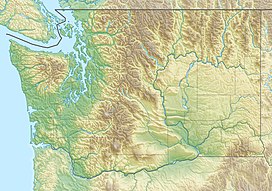Jefferson Peak
Mountain in Washington (state), United States From Wikipedia, the free encyclopedia
Jefferson Peak is a 5,720-foot (1,743 m) mountain summit located in the Olympic Mountains in Mason County of Washington state.[4] It is situated in the Mount Skokomish Wilderness, on land managed by Olympic National Forest. The mountain's toponym honors Thomas Jefferson (1743–1826), the third president of the United States.[5] The nearest higher neighbor is line parent Mount Pershing, 1.3 mi (2.1 km) to the southwest.[6] Precipitation runoff drains into Jefferson Creek and the Hamma Hamma River. Topographic relief is significant as the north aspect rises over 4,100 feet (1,200 m) above the Hamma Hamma valley in approximately one mile.
| Jefferson Peak | |
|---|---|
 Mt. Pershing (left) and Jefferson Peak (right) seen from West Seattle | |
| Highest point | |
| Elevation | 5,720 ft (1,743 m)[1] |
| Prominence | 600 ft (183 m)[2] |
| Parent peak | Mount Pershing (6,154 ft)[3] |
| Isolation | 1.30 mi (2.09 km)[3] |
| Coordinates | 47°33′41″N 123°13′55″W[4] |
| Naming | |
| Etymology | Thomas Jefferson |
| Geography | |
| Country | United States |
| State | Washington |
| County | Mason |
| Protected area | Mount Skokomish Wilderness |
| Parent range | Olympic Mountains |
| Topo map | USGS Mount Washington |
| Geology | |
| Rock age | Eocene |
| Rock type | pillow basalt |
| Climbing | |
| First ascent | 1958[2] |
| Easiest route | class 3 scramble via Goober Pond[2] |
Climbing
The first ascent of the summit was made in 1958 by Don Anderson, Bob Oram, Keith Spencer, and Robert Petersen.[2] There are three established scrambling routes to the summit: from Goober Pond, the North Couloir, and via the East Peak.[2] Jefferson Peak has a 250-foot-high (class 5.3) subpeak called "Tran Spire" (4,943 feet (1,507 m)) which was first climbed in 1958 by Don Anderson and Robert Petersen .[2][7]
Climate
Jefferson Peak is located in the marine west coast climate zone of western North America.[8] Weather fronts originating in the Pacific Ocean travel northeast toward the Olympic Mountains. As fronts approach, they are forced upward by the peaks (orographic lift), causing them to drop their moisture in the form of rain or snow. As a result, the Olympics experience high precipitation, especially during the winter months in the form of snowfall.[9] Because of maritime influence, snow tends to be wet and heavy, resulting in avalanche danger. During winter months weather is usually cloudy, but due to high pressure systems over the Pacific Ocean that intensify during summer months, there is often little or no cloud cover during the summer.[9] The months April through August offer the most favorable weather for viewing or climbing this mountain.[2]
Geology
The Olympic Mountains are composed of obducted clastic wedge material and oceanic crust, primarily Eocene sandstone, turbidite, and basaltic oceanic crust.[10] The mountains were sculpted during the Pleistocene era by erosion and glaciers advancing and retreating multiple times.
Gallery
See also
References
External links
Wikiwand - on
Seamless Wikipedia browsing. On steroids.






